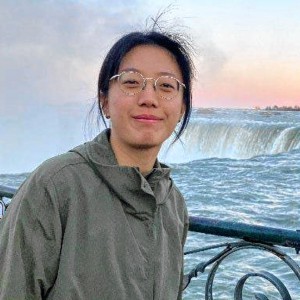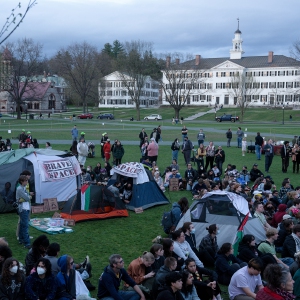Out & About: Barnard event offers glimpse into life during WWII

Liz Sauchelli. Copyright (c) Valley News. May not be reprinted or used online without permission. Send requests to permission@vnews.com.
| Published: 08-20-2023 12:31 AM |
EAST BARNARD — The first edition of The East Barnard Grange News “might be called the birth of a new idea,” a note from editor Donald Westbrook began.
It was February 1943, and the United States had been involved in World War II for just over a year.
Young people throughout the country, including East Barnard, had stepped up to serve their country, and people back home were looking for a way to stay connected to them.
“All the members of the Grange have been cudgelling their brains to arrive at a method whereby all our friends and relatives in the armed forces will be assured of receiving news of their home folks at fairly regular intervals,” Westbrook wrote. “Finally, from the blue, came the idea that news letter, published at such intervals as passing events indicate, would be just the thing. So — like it or not — here we go!”
That first edition kicked off 36 editions of the East Barnard Grange News, which was published monthly and sent around the world to roughly 25 people — men and women — from the East Barnard and Broad Brook areas.
Each edition was about eight pages, according to Paige Gibbs, president of the Barnard Historical Society.
The Barnard Historical Society has copies of each newsletter, which were saved by Westbrook’s family members. Each newsletter included updates from people in the service so that their compatriots knew what they were up to. That was followed by information about recent Grange activities, news from people in the community, an editor’s note from Westbrook and jokes.
Members of the public will have an opportunity to hear excerpts from the East Barnard Grange News on Sunday, Aug. 27, at 2 p.m. at the East Barnard Church, located at the intersection of Allen Hill and Broad Brook roads.
Article continues after...
Yesterday's Most Read Articles
 Police seek assistance in locating missing Dartmouth student
Police seek assistance in locating missing Dartmouth student
 City cites Claremont property owner over demolition of building
City cites Claremont property owner over demolition of building
 Editorial: Dartmouth lets protesters know where they stand
Editorial: Dartmouth lets protesters know where they stand
 DHMC union organizers say they have enough signatures to force vote
DHMC union organizers say they have enough signatures to force vote
 A Life: Elaine Chase ‘was a very generous person’
A Life: Elaine Chase ‘was a very generous person’
The program is free, and there will be refreshments.
“I’m the last generation who remembers who these people are and where they lived,” Gibbs said.
“The idea is to help people who now live in the area to now become acquainted with the people who lived in the houses they now occupy.”
Community members who are descendants of those who received the newsletter, or who live in houses that the recipients once lived in, will perform the readings as well as share memories of those who served.
Floyd Van Alstyne, a 103-year-old WWII veteran, received the newsletter while he was serving abroad and will read a passage.
In addition to transmitting news, the newsletters provided a bit of levity and insight into what was happening on the homefront.
Gibbs said there’s a comical account of a sleigh getting loose.
“There’s so many good stories,” she said.
Around 30 people will read excerpts from the newsletters in chronological order, which they will receive right before the program begins “so they would have the same kind of immediacy that you’d have wherever you were stationed and you were getting a letter from home and sharing it with your buddies,” Gibbs said. “They were sent truly all over the world.”
Among the participants sharing stories is John Leavitt, whose late older brother, Bud, served in the Navy.
“It kind of brings back a lot of memories when you start seeing those names of the soldiers and sailors and almost brings tears to your eyes to know what some of them went through,” Leavitt said. “Also what the people back home went through.”
Leavitt, who was a youth when the United States was part of World War II that was going on, remembers rationing — particularly of sugar and sweets.
“Candy bars were hard to get,” he recalled. When a local store owner would go to White River Junction to pick up groceries, children would help him unpack, eager to see if he was able to get any candy.
He also remembers how community members, mainly men, would gather at the local store on Tuesday and Saturday nights to share news about their loved ones who were serving overseas.
“They’d come down and talk about where their boys were or where their girls were in the world and anything that had happened to them,” Leavitt said, adding that they’d also listen to the radio. “Not gossip, but talking about their sons and daughters who were serving in the service. Everybody was interested.”
It was a real treat when one of those who served had leave and was able to make the trip home.
“Every once in awhile, you’d see someone in uniform, which made you real proud of them,” Leavitt said.
If his brother’s ship docked in Boston, sometimes he’d get a three-day pass to come home to East Barnard.
Bud Leavitt joined the Navy when he was 17 and got out shortly before his 20th birthday, Leavitt said.
“Those guys back then, they were just kids,” Leavitt said. “They were young, but they were our fighting forces, and they served us well.”
While many of the letters were heavily censored, Gibbs said people from East Barnard were stationed in New Guinea, North Africa and Italy.
At least one service member fought on the third day of D-Day and another took part in the Battle of the Bulge.
Only one person from the area the newsletter covered, Harold DeGrasse, was killed in action, Gibbs said.
When those who served returned, they usually kept mum about their military service and seldom disclosed the details.
“I knew them all,” Gibbs said. “You never heard a word of it.”
The newsletters, in some way, give insight into what it was like for them.
Gibbs hopes hearing the stories will give residents “a deeper feeling of belonging here” and put them in touch with the history of those who lived here before them.
For more information, email historicalbarnard1761@gmail.com. Liz Sauchelli can be reached at esauchelli@vnews.com or 603-727-3221.






 Kenyon: No respite from conflict in Upper Valley
Kenyon: No respite from conflict in Upper Valley A Life: Peggy Thorp ‘was critical to getting it all done’
A Life: Peggy Thorp ‘was critical to getting it all done’
